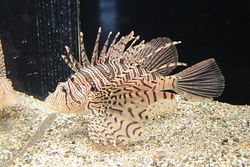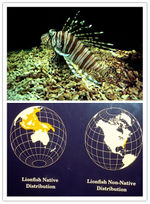
- Domain: Eukaryota
- Kingdom: Animalia
- Phylum: Chordata
- Class: Actinopterygii
- Order: Scorpaeniformes
- Family: Scorpaenidae
- Subfamily: Pteroinae
- Genus: Pterois
| Lionfish |
|---|
 |
| Scientific Classification |
|
| Species |
| Distribution of lionfish in the Atlantic Ocean in 2009 |
Lionfish are any of the species of marine fish belonging to the taxonomic genus Pterois. They are best known for their venomous spines and for the predatory nature from which their name is derived. They are native to the South Pacific and Indian Ocean, and considered an invasive species to many other areas. [2] Their desired habitat is still waters away from water currents, and dark areas in the ocean. When approaching its prey the lionfish hides in the coral or dark gaps in rocks, then when its prey (a wide variety of small fish and crustaceans) swims by its corners the prey with its large fins and then swallows the prey whole. [3] The lionfish greatly affects the native reefs by eating the fish which causes a decrease in the population, which can include many important species. This invasive species contain a venomous sting that causes much pain, sweating, respiratory distresses and even paralysis which is injected with its dorsal fins.[4] The lionfish is one of the most venomous on the ocean floor.[5]
Standing at about 1 foot, no more than 2.6 pounds, the lionfish size may vary. The lionfish is a unique which has colors and a body design of which it may send predators to stay away alerting them that it is not a good food source to it. The lionfish also can be dangerous because of its venom it releases thru its needle like dorsal fins. As we go along the lionfish has a beautiful white and orange lines as like a zebra stripe design on it flat body shape, also has long pectoral fins. The colors may vary for this species, which has multiple sub species, with much more colors and sizes. [6]
There are different spices of lionfish, one of the different types of lionfish is the the red lionfish which has 13 dorsal fins 10-11 dorsal soft rays, 3 anal spines, and 6–7 anal soft rays, but other may have different amount of fins, and etc. On the red lionfish all of the fins on the membrane are spotted and also the Coastal populations are generally darker and can almost black in estuaries. [7]
The lionfish reaches maturity around 2 years of age. When they're ready to mate, a male groups together several females. During this process, the male becomes extremely aggressive, and will charge any male competition, head-butting him into submission. When the lionfish are ready to mate, they can change their colors. The male gets darker, and the female gets paler. He will then dance around her, seducing her, and they will swim up to the surface. The female will then release 10,000-30,000 eggs that the male will fertilize. Once the egg hatches, the baby spends it's larval stages hiding in rock crevices. They stay in the larval stage for 20-40 days. And they grow quickly, maturing at 2 years, they can reproduce quickly.[8]

Lionfish are found in mostly all marine habitat types found in warm marine waters of the tropics. Lionfish have been found in water depths from 1 to 1000 feet on hard bottom, mangrove, seagrass, coral, and artificial reefs (like shipwrecks).[9]For example, the high densities of lionfish observed in locations such as the Bahamas may be causing an abrupt change to the biodiversity and community structure of reef fish communities.[10] Extreme temperatures present geographical constraints in the distribution of aquatic species, indicating temperature tolerance plays a role in the lionfish’s survival, reproduction, and range of distribution.The abrupt differences in water temperatures north and south of Cape Hatteras directly correlate with the abundance and distribution of Pterois.Pterois expanded along the southeastern coast of the United States and occupied thermal-appropriate zones within 10 years. [11] Also, Lionfish can tolerate a minimum salinity of 5 parts per thousand and even withstand pulses of freshwater, which means they can also be found in estuaries of freshwater rivers.[12]Lionfish are established in the offshore waters of the Southeast United States and throughout most of the Caribbean, and are presently invading the Gulf of Mexico and parts of South America. Lionfish are expected to invade the remainder of the Caribbean and to continue the southward expansion along the coast of South America until water temperatures below the lionfish thermal tolerance limit continued expansion.[11]
For lionfish, all the species are aposematic: they have conspicuous coloration with boldly contrasting stripes and wide fans of projecting spines, advertising their ability to defend themselves. Lionfish prey mostly on small fish, invertebrates, and mollusks in large amounts, with some specimens’ stomachs containing up to six different species of prey.Aside from instances of larger lionfish individuals engaging in cannibalism on smaller individuals, adult lionfish have few identified natural predators. This is likely due to the effectiveness of their venomous spines. Moray eels,bluespotted cornetfish, and large groupers, have been observed preying on lionfish. [11]
The lionfish (Pterois miles) is a very dangerous invasive species. They can breed at an almost unheard of rate, they eat or starve out local fish, disrupt commercial fishing, and threaten tourism. They have a sharp spine that contains a powerful venom, so they have no predators. And when a lionfish goes to eat, it herds smaller fish into pockets of coral reef or up against barriers, and then they swallow all the prey in a single fluid motion. These dangerous invaders can/have consumed more than 50 different species, and can expand their stomach up to 30 times their normal size after a meal, so they can just keep eating. If they keep this up, it could threaten all of the fish species! [13]
The lionfish is an aggressive predator that eats 60,000 reef fish before it is 2 years old, therefore control efforts are necessary to prevent them from having an adverse affect on reef populations.[14] In Bimini, every year there's an event called: "Woody's Lionfish bash!" At this event, divers compete to see who can spear the most lionfish. This event has raised more than $400,000 in 3 years! And in Florida, you can go and spear lionfish anytime you want, as long as you have the proper equipment. In a day, around 1,400 lionfish are harvested, but just 1 lionfish can produce 200,000 eggs per month, meaning that having even 1 survivor means a whole new population of lionfish. [15]
Local control efforts are critical for mitigating the effects of lionfish on key marine habitats. These efforts are invaluable for supporting other conservation initiatives, such as management of marine protected areas and fisheries stock rebuilding, managers must be prepared for long-term intervention. [16]So, how do we stop these insane invaders? Right now, the answer is still unknown. But people are struggling to find the best method to control invasive behavior of lionfish. Because for example, in the Bahamas, their numbers continue to expand. They are spreading throughout the Caribbean Sea. Eradication appears almost impossible. Even limited amounts of control will be extremely difficult, and right now the best available plan is to capture and eat them.[17]
So depend on different conditions and different categories of lionfish, people need to find out various ways to control them.
Invasion of the Lionfish
|
||||||||||||||||||||